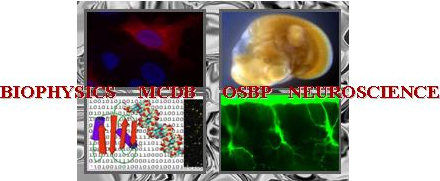Interdisciplinary Graduate Programs Symposium

2013 OSU Molecular Life Sciences
Interdisciplinary Graduate Programs Symposium

Talk abstracts
Abstract:
tRNA serves an essential role in translation. It is now known that tRNAs move from the cytoplasm to the nucleus via retrograde nuclear import and can again access the cytoplasm via the re-export step. The tRNA retrograde process is responsive to nutrient availability. My research is to investigate the regulation of tRNA subcellular dynamics. Los1, the b-importin family member, functions in nuclear export of mature tRNA and intron-containing pre-tRNAs. Intron-containing pre-tRNAs are processed by tRNA splicing machinery located on the surface of mitochondria. The b-importin family member Msn5 has been implicated in tRNA nuclear export. Although tRNA accumulates in the nucleus in msn5Δ, our in vivo data provide evidence that Msn5 exports only spliced tRNA, and perhaps aminoacylated tRNA (aa-tRNA). However, in vitro studies indicate that Msn5 does not have specificity for mature tRNA. To account for the difference, I hypothesized that other proteins aid Msn5’s in vivo specificity to recognize mature tRNA. Previous studies implicated Tef1/2 (vertebrate eEF1A) in tRNA export and I showed that Tef1/2 can access the nucleus, a prerequisite if Tef1/2 directly functions in tRNA export. To address whether Tef1/2 aids formation of tRNA re-export complex, I employed in vivo pull down assay using cells with endogenously tagged proteins and with inducible Ran locked in the GTP-bound states to maintain the export complex. My data indicate that Los1 interacts with both intron-containing and mature tRNAs, while Msn5 may prefer to interact with mature tRNAs. Tef1 and Ran co-purify with Msn5 in a RanGTP-dependent manner. Based on the predicted structure of Msn5 with tRNA, it is still unclear how and if Msn5 and Tef1/2 form an export competent cooperative complex with aa-tRNAs and RanGTP or Tef1/2 might hand-off aa-tRNAs to Msn5. From the cell biology study, I found that the subcellular distribution of the exportins is sensitive to the glucose depletion and inhibition in translation initiation. Our data suggest that there are likely three levels of control that connect nutrient conditions to tRNA subcellular distribution: 1. aminoacylation level of tRNA in the nucleus; 2. nuclear-cytoplasmic distribution of the exportins; 3. post-translational modifications of the exportins. I am testing the third mechanism by using MS analysis.
Keywords: tRNA re-export